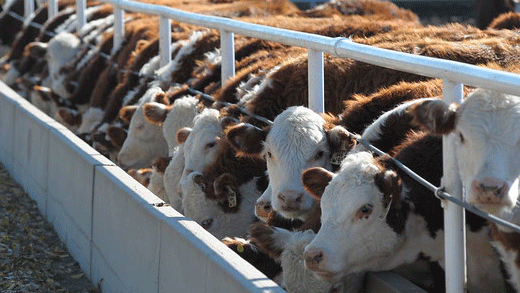
Disruptions in the meat supply chain linked to the COVID-19 pandemic has cut industry processing capacity by 40%. Now is not the time, however, to make sweeping changes to the industry structure itself, K-State agricultural economists say. | Download this photo.
Ag economists warn against overreaction to meat industry structure in face of COVID-19
‘Be cognizant of how we got here,’ one specialist says
May 6, 2020
MANHATTAN, Kan. – Tumultuous times in the meatpacking industry linked to the current new coronavirus pandemic has prompted calls for changes to the structure of the industry, but two Kansas State University agricultural economists are warning against overreactions to a structure that has been years in the making.
Hundreds of cases of COVID-19 have been confirmed in some of the biggest meatpacking plants in the country, leading to supply chain disruptions as companies deal with absent workers and temporarily close plants, leading to a 40% loss of capacity in the industry.
The closures left livestock producers with a backlog of animals ready to go to market, which means higher feed costs and potentially heavier animals. On the other end of the supply chain, the disruptions mean spotty meat availability in grocery meat cases, with some supermarkets temporarily imposing limits on how much meat shoppers can buy.
Listen to ag economists Glynn Tonsor and Ted Schroeder on the radio program, Agriculture Today with Eric Atkinson
Prompted by the situation, on April 28 President Donald Trump deemed meatpacking plants as “critical infrastructure” that must stay open.
The pandemic and its effect on everyone along the meat supply chain including consumers has sparked calls for changes in the structure of the meatpacking industry, which is largely concentrated to four companies – Smithfield Foods, Tyson Foods, JBS and Cargill Meat Solutions. The four control about 80% of the meat slaughter capacity in the United States.
“We’re in a situation I don’t think our industry or our society has ever really faced, or realized the challenges associated with an event like this,” said University Distinguished Professor of agricultural economics, Ted Schroeder.
The health of packing plant employees, livestock supplies backing up, changes in demand linked to school and restaurant closures are all happening at the same time “and each segment of the industry is trying to fulfill its role the best they can,” he said. “It makes for an industry that’s under a lot of stress. But it’s not just this industry, it’s across society.”
“I’m hopeful that we’re in the worst of it, in terms of lost capacity,” said K-State professor and livestock marketing specialist Glynn Tonsor, adding that as of May 4, U.S. processing capacity was about 40% lower than it was in the same week last year. “Let’s hope that’s the lowest it will go, but no guarantee.”
Unlike grains that can be stored long term, meat is a perishable commodity which makes decision making more complicated in situations like this when there are such large disruptions in the supply chain flow.
The situation, Tonsor said, has rekindled conversations about meatpacker concentration, but he cautioned against making big changes in the midst of the current crisis.
“In general, when you have a surgical procedure, the doctor will give you advice for when you get home or for the next couple of weeks but doesn’t tell you to quit exercising for the rest of your life,” Tonsor said.
The current concentration in meat packing came about because of economies of scale, Tonsor said, which allows those companies to produce higher volumes at lower costs per animal than a smaller company could do. That efficiency means lower prices for consumers.
“Also, the value of U.S. meat exports has grown notably over the last couple of decades,” he said. “The beef industry is becoming increasingly reliant on the export market to sustain the current size of the industry.” Keeping that in mind, it’s easier for an overseas buyer to deal with one company than 30 companies.
“An overreaction to our current structure could mean a loss of global competitiveness,” he added.
Schroeder reminded that meat packing is a labor-intensive segment of the industry where a significant number of highly skilled people are needed, no matter who owns that segment.
“The nature of our plants, the size of our plants, have evolved to where labor productivity is as high as any other alternative that we currently have,” he said.
The pandemic may push meatpacking companies to look more closely at automating more parts of the process, rather than rely so heavily on human labor, Tonsor said.
The coronavirus pandemic has also reignited discussions about price discovery in beef cattle, which has changed in the past seven years, most notably with a shift to formula pricing and away from negotiated trade, Schroeder said.
Though some believe there’s greater transparency in negotiated trades, the middle of a crisis is not the time to make sweeping, long-term changes, he added.
“There’s always room for improvement, but I think that it’s dangerous to jump off the cliff without studying what’s on the other side, so to speak,” Tonsor said.
“It’s better to look at how and why the current system came to be and can we take the current system and enhance the information that we get to make it work more efficiently and effectively,” Schroeder said. “The ways we’re marketing and valuing cattle today has evolved because they offer great opportunity to increase the value signals being sent to the industry.”
Any significant changes, whether linked to the pandemic or otherwise, should be made with an eye toward benefits to the cattle producer, the meat packer, the retailer and the consumer.
“Those balancing acts are very emotional in the midst of a crisis. I don’t want to see us overreact in the midst of a crisis to do undue harm in the future,” Tonsor said.
An Agriculture Today interview with Tonsor and Schroeder is available online at www.agtoday.net.
Check K-State Research and Extension COVID-19 for more resources.

